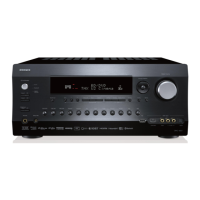Advanced Operations
En-78
Operating procedure (➔ page 59)
■ Audio TV Out (HDMI)
` Off
` On
This preference determines whether the incoming
audio signal is output from HDMI OUT. You may want
to turn this preference on if your TV is connected to
HDMI OUT and you want to listen to the audio from a
connected component through your TV’s speakers.
Normally, this should be set to “Off”.
Note
• If “On” is selected and the audio can be output from the TV,
the AV controller will output no sound through its speakers.
In this case, “TV Speaker” appears on the AV controller’s
display by pressing Display.
• When “HDMI CEC (RIHD)” is set to “On”, this setting is
fixed to “Auto”.
• When “Speakers Type(Front)” is set to “Digital
Crossover”, this setting is fixed to “Off”.
• This setting is fixed to “Off” when “Monitor Out” is set to
“HDBaseT(TM)” (➔ page 60).
• With some TVs and input signals, no sound may be output
even when this setting is set to “On”.
• When “Audio TV Out (HDMI)” or
“HDMI CEC (RIHD)” is set
to
“On” and you’re listening through your TV’s speakers,
turning up the AV controller’s volume control will make the
sound be output from the AV controller’s front left and right
speakers. To stop the AV controller’s speakers producing
sound, change the settings, change your TV’s settings, or
turn down the AV controller’s volume.
• Listening mode cannot be changed when this setting is set
to “On” and the audio is output from the TV.
• If the audio signal from the player is not supported by the
TV, the audio is not output from the TV even if this setting
is enabled. When the audio cannot be output from the TV,
(When “Monitor Out” is set to “Both”, the audio cannot be
output form the TV connected to both HDMI OUT and
HDBaseT(TM)) the audio is output from the speakers
connected to the AV controller.
■ Audio TV Out (HDBaseT(TM))
` Off
` On
This preference determines whether the incoming
audio signal is output from HDBaseT(TM). You may
want to turn this preference on if your TV is
connected to HDBaseT(TM) and you want to listen to
the audio from a connected component through your
TV’s speakers. Normally, this should be set to “Off”.
Note
• If “On” is selected and the audio can be output from the TV,
the AV controller will output no sound through its speakers.
In this case, “TV Speaker” appears on the AV controller’s
display by pressing Display.
• When “Speakers Type(Front)” is set to “Digital
Crossover”, this setting is fixed to “Off”.
• This setting is fixed to “Off” when “Monitor Out” is set to
“HDMI” (➔ page 60).
• When “Monitor Out” is set to “Both” (➔ page 60), and this
setting is enabled, set audio output of source component to
2ch PCM.
• With some TVs and input signals, no sound may be output
even when this setting is set to “On”.
• When “Audio TV Out (HDBaseT(TM))” is set to
“On” and
you’re listening through your TV’s speakers, turning up the
AV controller’s volume control will make the sound be
output from the AV controller’s front left and right speakers.
To stop the AV controller’s speakers producing sound,
change the settings, change your TV’s settings, or turn
down the AV controller’s volume.
• Listening mode cannot be changed when this setting is set
to “On” and the audio is output from the TV.
• When “Monitor Out” is set to “Both” (➔ page 60) and only
“Audio TV Out (HDBaseT(TM))” is set to “On”, the audio is
not output from the TV connected to HDBaseT(TM) except
in the case the audio input is via HDMI.
• If the audio signal from the player is not supported by the
TV, the audio is not output from the TV even if this setting
is enabled. When the audio cannot be output from the TV,
(When “Monitor Out” is set to “Both”, the audio cannot be
output form the TV connected to both HDMI OUT and
HDBaseT(TM)) the audio is output from the speakers
connected to the AV controller.
■ Audio Return Channel
` Off
` Auto:
The audio signal from your TV tuner can be sent
to HDMI OUT of the AV controller.
The audio return channel (ARC) function allows an
ARC capable TV to send the audio stream to HDMI
OUT of the AV controller. To use this function, you
must select the TV/CD input selector and your TV
must be ARC capable. Default setting: “
-----”
Note
• This setting is fixed to “-----” when the “HDMI CEC
(RIHD)” setting is set to “Off”.
• This setting is set to “Auto” automatically when the “HDMI
CEC (RIHD)” setting is set to “On” for the first time.
• If you set “Audio Return Channel” to “Auto”, the “Audio
Selector” settings of the TV/CD input selector will be
automatically switched to “ARC” (➔ page 73).
Tip
• After changing the settings of the “HDMI CEC (RIHD)”,
“HDMI Through” or “Audio Return Channel”, turn off the
power on all connected pieces of equipment and then turn
them on again. Refer to the user’s manuals for all
connected pieces of equipment.
■ Lip Sync
` Off
` On
This function allows the AV controller to automatically
correct any delay between the video and the audio,
based on the data from the connected monitor.
Note
• This function works only if your HDMI-compatible TV
supports HDMI Lip Sync.

